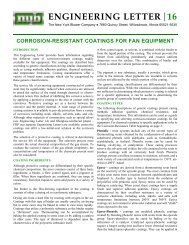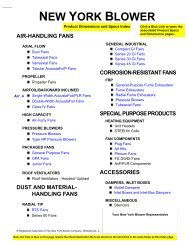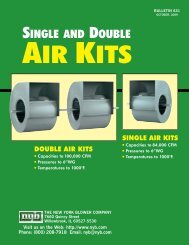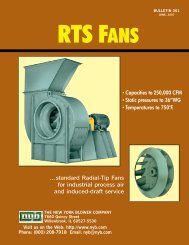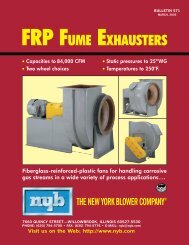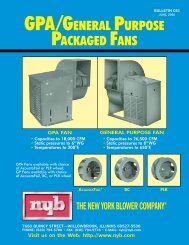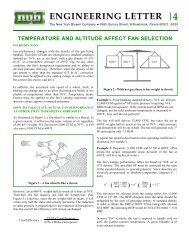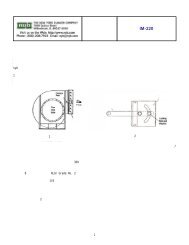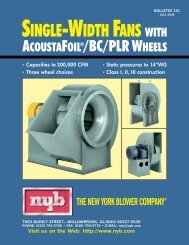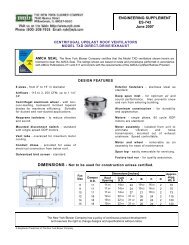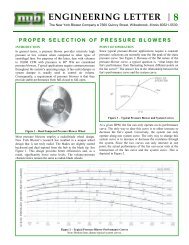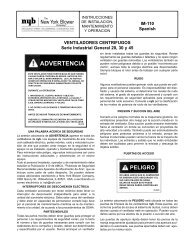Engineering Letter Glossary - New York Blower
Engineering Letter Glossary - New York Blower
Engineering Letter Glossary - New York Blower
Create successful ePaper yourself
Turn your PDF publications into a flip-book with our unique Google optimized e-Paper software.
BACKDRAFT DAMPER damper used in a system to relieveair pressure in one direction and to prevent airflow in theopposite direction.BALANCING the process of adding (or removing) weight on arotor in order to move the center of gravity toward the axis ofrotation.BARCOL NUMBER a standard measure of FRP surface hardness.BAROMETRIC PRESSURE a measurement of the pressure ofthe atmosphere; standard is 29.92" Hg.BEARING LOSSES the power losses resulting from friction inthe main bearings.BERNOULLI’S THEOREM the principle that the total energyper unit of mass in the streamline flow of a moving fluid isconstant, being the sum of the potential energy, the kineticenergy, and the energy due to pressure. In terms of airmovement, the theorem states that the static pressure plusvelocity pressure as measured at a point upstream in the directionof airflow is equal to the static pressure plus velocity pressureas measured at a point downstream in the direction of airflowplus the friction and dynamic losses between the points.BI fan wheel design with backwardly-inclined blades.BILLET a section of semi-finished metal or non-ferrous alloy.BLADE LINERS pieces of material added over the wheelblades to reduce abrasion of the blades.BLADE-PASS FREQUENCY the tone generated by the bladespassing a fixed object.BLAST AREA the fan outlet area less the projected area of thecut-off.BOILER HORSEPOWER the capability to evaporate 34.5pounds of water per hour into dry steam at 2 12°F. at sea level;33,500 BTU/Hr.BRAKE HORSEPOWER [BHP] mechanical energy consumedat a rate of 33,000 ft. lbs. per minute; a consumption rating, ascompared to the production rating of horsepower itself.BREAKDOWN TORQUE maximum torque a motor willproduce without a sudden decrease in speed. Often referred toas pull-out torque or maximum torque.BRINELL NUMBER a standard measure of metal surfacehardness; metals with Brinell hardness ratings of 250 or moreare generally considered abrasion-resistant.BTU British Thermal Unit; heat required to raise thetemperature of 1 pound of water by 1 °F. The Btu/hr. required toraise the temperature of a volume of standard air a specificnumber of degrees is calculated by the formula:Btu/hr = Temp. Rise x CFM x 1.085CAPACITOR START MOTOR type of single-phase inductionmotor with a capacitor connected in series with the startingwinding. High-starting and breakdown torque, medium startingcurrent. Used in hard-starting applications; compressors,pumps, etc.CAPTURE VELOCITY air velocity necessary to overcomeopposing air currents or natural flow and cause contaminatedair, fumes, or material to flow in a desired direction.CATALYST the final ingredient that triggers the chemicalreaction known as curing, which converts liquid resin to a solid.CELSIUS a thermometric scale in which water boils at 100°and freezes at 0°, same as centigrade:°C = .5556 x [°F. - 32°]CENTRIFUGAL FAN a fan design in which air is dischargedperpendicular to the wheel’s rotational axis.CFM cubic feet per minute; the volume of flow for a givenfan or system.COATINGS specialty coverings, typically referred to as paints,with varying degrees of resistance to atmospheric or chemicalcorrosion.COEFFICIENT OF CONDUCTIVITY the rate of heat transferthrough a material, expressed in Btu transmitted per hourthrough one square foot of surface per degree difference intemperature across the material. Figures are usually expressedfor basic materials, such as wood or insulation; per inch ofthickness, and called by the symbol “K”.COMPRESSIBILITY a factor used by fan manufacturers tocorrect performance ratings in higher pressure ranges toaccount for the fact that air is a compressible gas that does notfollow the perfect gas laws.COMPRESSION a phenomenon related to positive pressure.When air is forced into a system it is compressed and becomesmore dense. Depending on the volume or weight of airrequired down stream in the positive pressure portion of thesystem, the volume of air at the inlet of a fan may have to beadjusted by the ratio of absolute pressure at the entrance of thefan versus the design requirements in the system.CONVEYING VELOCITY the air velocity required in a ductsystem to maintain entrainment of a specific material.CORROSION the deterioration of a material by chemical orelectrochemical reaction resulting from exposure to weathering,moisture, chemical, or other agents in the environment inwhich it is placed.CRP Certified Ratings Program.CSA Canadian Standards Association. Sets safety standards formotors and other electrical equipment used in Canada.Page 2
CURVE, FAN PERFORMANCE a graphic representation of EFFICIENCY, STATIC the ratio of fan output less the kineticTP x CFMFOOT-POUND (Ft. - Lb.) torque rating or requirement;ME = 6356 x BHP equivalent to the force required to move a one-pound weightstatic or total pressure and fan BHP requirements over anairflow volume range at a stated inlet density and fan speed.energy [outlet-velocity pressure] leaving the fan to the powerapplied to the fan:CURVE, SYSTEM a graphic representation of the pressureSP x CFMSE =versus flow characteristics of a given system and density.6356 X BHPDAMPER an accessory to be installed at the fan inlet or outletfor air-volume modulation.dbA sound-pressure level corrected to the “A” weighingnetwork.DECIBEL the logarithmic ratio between some known referenceELEVATION the distance of the subject site above or belowsea level.END REFLECTION a known value of sound radiated backinto a duct or opening.ENTHALPY the heat content per unit mass of a substance.and some quantity of electric or acoustic signal power.ENTRY LOSS the loss in pressure caused by air flowing into aDENSITY the measure of unit mass equal to its weight divided system; normally expressed in fractions of velocity pressure.by its volume (lbs./ft.3); standard air is .075 lbs./ft. 3 .EQUIVALENT DUCT DIAMETER for rectangular duct withDEW POINT the temperature at which condensation begins to sides a and b is:form as air is cooled.D = (4ab/π) 0.5DFT dry-film thickness usually expressed in thousandths ofan inch (mils).EVASE a diffuser at the fan outlet which gradually increases inarea to decrease velocity and to convert kinetic energy to staticDIFFERENTIAL PRESSURE the difference of static pressuresat the fan outlet and inlet; also see FAN CAPACITY.DILUTION VENTILATING the mixing of contaminated airwith uncontaminated supply air for the purpose of attainingacceptable working or living conditions.DIRECTIVITY FACTOR the number representative of theradiation characteristics of a sound source.pressure [regain.]FAHRENHEIT a thermometric scale in which water boils at212° and freezes at 32°.°F = (1.8 x °C) + 32°FAN a power-driven machine which moves a continuousvolume of air by converting rotational mechanical energy to anincrease in the total pressure of the moving air.DRY-BULB TEMPERATURE the combined temperature of awater vapor and air mixture.FAN CAPACITY performance requirement for which a fan isDUST air suspension of particles [aerosol] of any solidselected to meet specific system calculations given in terms ofACFM at the fan inlet.material, usually with a particle size smaller than 100micrometers.FAN CLASS operating limits at which a fan must be physicallycapable of operating safely.DUST COLLECTOR an air-cleaning device used to removeheavy-particulate loadings from exhaust systems prior to FAN LAWS theoretical constant relationships between CFM,discharge.RPM, SP, and BHP for a given fan used in a given fixedsystem:DWDI double-width, double-inlet fans, Arrangement 3.CFM varies as RPMDYNAMIC BALANCE the mechanical balancing of a rotatingpart or assembly in motion.DYNAMIC INSERTION LOSS a reduction of airborne noiseSP varies as (RPM) 2BHP varies as (RPM) 3FC fan wheel design using forward-curved blades.levels affected by the installation of an acoustical silencer.FINITE ELEMENT ANALYSIS (FEA) computerized analyticalDYNE a unit of force equal to that which would accelerate one technique used to divide a rotating body into many segments togram by one centimeter per second.determine the stress of each segment and therefore thecomplete body.EFFICIENCY, MECHANICAL TOTAL the ratio of fan outputto the power applied to the fan. Can be helpful in selecting fan FLASHING sheet-metal strip placed at the junction of intersectingsize, type, or manufacturer for the same application:exterior building surfaces to make the joint water-tight.one foot in distance, equal to 12 in.-lb.Page 3
FORCED DRAFT how air is provided in a process, such as acombustion process; when air is blown or forced into a process,it is known as a “forced draft” system. Also see induced draft.FPM feet per minute; commonly defines air velocity (todetermine velocity pressure or suitability for materialconveying),shaft/bearing speeds (used to determine lubricationrequirements) and wheel tip speeds.FRAME SIZE a set of physical dimensions of motors asestablished by National Electrical Manufacturers Association(NEMA) for interchangeability between manufacturers.Dimensions include; shaft diameter, shaft height, and motormounting foot print.FREE FIELD the surroundings of a specific equipmentlocation in which no obstructions or reverberant surfaces exist todistort or amplify sound waves.FREQUENCY any cyclic event whether vibration, alternatingcurrent, or rotational speed. Usually expressed in cycles persecond (cps) or just “cycles.”FRICTION LOSS resistance to air flow through any duct orfitting, given in terms of static pressure.FRP abbreviation for fiberglass-reinforced-plastic.FULL-LOAD SPEED the speed at which the rated horsepoweris developed. This speed is less than synchronous speed andvaries with motor type and manufacturer.FULL-LOAD TORQUE the torque required to produce therated horsepower at full-load speed.FUMES airborne particles, usually less than 1 micrometer insize, formed by condensation of vapors, sublimation, distillation,or chemical reaction.GALVANIZING the process of coating or plating with a zincrichsolution; can be a hot-dip process, cold spray, or brushapplication.GAS STREAM the specific airstream composition within anyfan or system.GASES formless fluids which tend to occupy an entire spaceuniformly at ordinary temperatures and pressures.GAUGE (GAGE) metal manufacturers’ standard measure ofthickness for sheet stock; some examples for steel are:GaugeThickness(Inches)Weight of Steel(Lbs./Ft. 2 )7 .1793 7.5010 .1345 5.62512 .1046 4.37514 .0747 3.12516 .0598 2.50GAUGE PRESSURE the pressure differential betweenatmospheric and that measured in the system.GEL COAT a special resin system, sometimes includingpigment, but without glass-reinforcing, that is applied to themold before applying the FRP.GROUND MOTOR a short circuit between any point in themotor’s electrical circuit and its connection to the ground.HEAT EXCHANGER a device such as a coil or radiator whichis used to transfer heat between two physically separatedfluids.HEPA FILTER high-efficiency particulate air filterscommonly called absolute filters.HERTZ frequency measured in cycles per second.Hg symbol for mercury. Pressure is often measured in inchesof mercury: (1" Hg. = 13.64" WG)HORSEPOWER (as applied to motors) is an index of theamount of the work the machine can perform in a period oftime. 1 HP equals 33,000 ft. lbs. of work per minute, alsoequal to 0.746 kilowatts. Horsepower can be calculated by:HP =Torque (ft. lbs.) x RPM5250HOUSING the casing or shroud of a centrifugal fan.HVAC heating, ventilating, and air conditioning.IMPELLER another term for fan “wheel.” The rotating portionof the fan designed to increase the energy level of the gasstream.IMPELLER DIAMETER the maximum diameter measuredover the impeller blades.IMPINGEMENT striking or impacting; such as materialimpingement on a fan wheel.INCH OF WATER unit of pressure equal to the pressureexerted by a column of water one inch high at a standarddensity (27.73" water = 1 PSI).INCH-POUND torque equal to one-twelfth foot pound.INCLINED MANOMETER a metering device used to obtainaccurate pressure measurements.INDUCED DRAFT how air is provided in a process, such as acombustion process; where air is drawn or pulled through aprocess. Also see forced draft.INDUCTION the production of an electric current in a conductorin a changing magnetic field.INERTIA tendency of an object to remain in the state it is in;see WR 2 .INLET-VANE DAMPER round multiblade damper mountedto the inlet of a fan to vary the airflow.Page 4
INSTABILITY the point of operation at which a fan or systemwill “hunt” or pulse; common in FC fans and some other fantypes where the point of operation is left of the peak of thestatic-pressure curve.INTERFERENCE FIT specified interference between matingparts requiring either a press fit or a shrink fit.KELVIN see Absolute Temperature.KILOPASCAL Kpa; metric pressure unit; one inch watergauge is 0.24836 Kpa.KILOWATT Kw; measure of power equal to 1.34 horsepower.L-10 BEARING LIFE the theoretical number of hours afterwhich 90% of the bearings subjected to a given set of conditionswill still be in operation; also known as B-10.LAMINAR FLOW gas or fluid in parallel layers with somesliding motion between the layers.LAMINATE the total structure of the FRP part. For nybcorrosion-resistant products it consists of a resin-rich surfaceand a thickness of glass-reinforced resin as required forstructural strength.LITHIUM a soft element in the alkali metal group commonlyused as a lubricant base.LOGARITHM a mathematical term used as a basis of thedecimal system. A logarithm is the exponent of 10 whichproduces a given number. For instance the log of 100 is 2 since:log 10 100 = 2 10 2 = 100LOUVER a device comprised of multiple blades which, whenmounted in an opening, permits the flow of air but inhibits theentrance of undesirable elements.LOWER EXPLOSIVE LIMIT the lowest percentage of anelement in otherwise standard air that will explode whenexposed to a spark.MACH NUMBER a fraction of the speed of sound; used in fanengineering where air moving at a mach number of 0.9, or 9/10the speed of sound, begins to deviate from the fan laws.MAKE-UP AIR a ventilating term which refers to thereplacement of air lost because of exhaust air requirements.MANOMETER instrument for measuring pressure, u-shaped,and partially filled with liquid, either water, light oil, ormercury.MAXIMUM CONTINUOUS RATING the point at which thefan is expected to operate.MICROBAR a unit of pressure equal to one-millionth of anatmospheric pressure; 0.0000 146 PSI.MICRON a unit of measure equal to one-millionth of a meter,commonly used in dust collection and material-handlingapplications to designate particle size.MIL a unit of measure equal to 25 microns or one-thousandthof an inch.MIXED-FLOW FAN a fan where the airflow is primarilyaxial and is changed by the blade shape to induce a small radialflow at the discharge.MOLECULAR WEIGHT the weight of a molecule expressedon a scale in which the carbon isotope weighs exactly 12.0;represents the sum of the weights of all the atoms in a molecule.As air is a gas mixture, it does not have a true molecularweight but an apparent molecular weight determined by thepercentages of the molecular weights of each gas in acomposition.NACE National Association of Corrosion Engineers.NATURAL FREQUENCY the frequency at which a componentor system resonates.NEC National Electrical Code.NEMA the National Electrical Manufacturers Association;the trade association establishing standards of dimensions,ratings, enclosures, insulation, and other design criteria forelectric motors.NOISE CRITERIA a way for an architect to specify themaximum permissible sound-power level in each of the eightoctave bands. NC curves give, in a graphical form, maximumpermissible intensity per octave band.OCTAVE BANDS ranges of frequencies. These octave bandsare identified by their center frequencies (63, 125, 250, etc.).OHM a measure of electrical resistance. A wire in which onevolt produces a current of one ampere has a resistance of oneOhm.OPPOSED-BLADE DAMPER a type of damper whereadjacent blades rotate in the opposite direction.OSHA Occupational Safety and Health Administration.OSI ounces per square inch; a unit of pressure equal to onesixteenthPSI or 1.733 inches of water.PARALLEL-BLADE DAMPER a type of damper where theblades rotate in the same direction.PARALLEL FANS two or more fans which draw air from acommon source and exhaust into a common duct or plenum. Aparallel fan arrangement is generally used to meet volumerequirements beyond that of single fans. Two identical fans inparallel will effectively deliver twice the rated flow of any oneof the fans at the same static pressure.PERMANENT SPLIT CAPACITOR MOTOR very low startingtorque. Performance and applications similar to shaded polebut more efficient, with lower line current and higher horsepowercapabilities.pH a symbol as part of a logarithmic designation to indicateacidity or alkalinity on a scale from 0 to 14; pH7 is taken asneutral, 6 to 0 increasingly acid, 8 to 14 increasingly alkaline.Page 5
PHENOLIC a thermosetting resin system used for coatings andadhesives.PIEZOMETER RING a device consisting of a number ofpressure taps connected to a common manifold to measurepressure.PITCH DIAMETER the mean diameter or point at which V-beltsride within a sheave. This dimension is necessary for accuratedrive calculations.PITOT TUBE a metering device consisting of a double-walledtube with a short right-angle bend; the periphery of the tube hasseveral holes through which static pressure is measured; thebent end of the tube has a hole through which total pressure ismeasured when pointed upstream in a moving gas stream.PLENUM a chamber or enclosure within an air-handlingsystem in which two or more branches converge or wheresystem components such as fans, coils, filters, or dampers arelocated.POINT OF OPERATION the intersection of a fan’s staticpressure curve and the system curve to which the fan is beingapplied; may be designated as velocity pressure divided bystatic pressure or by a given CFM and SP.POLES the number of magnetic poles established inside anelectric motor by the placement and connection of thewindings.POLYESTER a large group of thermosetting plastics whichexhibit a high degree of corrosion-resistance over a widespectrum of corrosive agents.PSI pounds per square inch measured in gauge pressure, notincluding atmospheric.PSIG pounds per square inch measured in gauge pressure, notincluding atmospheric.PSYCHROMETRIC CHART a graphic depiction of therelationship between pressure, density, humidity, temperature,and enthalpy for any gas-vapor mixture, used extensively incomfort ventilation.PULL-OUT TORQUE breakdown torque.PURE TONE a sound that is characterized by a very uniformwave pattern. Such a sound might be created by a tuning fork.PVC polyvinyl chloride; a synthetic thermoplastic polymer.QUADRANT commonly the damper control plate.RADIAL BLADE fan wheel design with blades positioned instraight radial direction from the hub.RANDOM NOISE a sound that has an average amplitude andconstantly changing frequency.RANKINE see Absolute Temperature.RAREFICATION a phenomenon related to negative pressure.When air is drawn through resistance into a fan inlet, the air isstretched out, or rarefied, and becomes less dense than at theentry to the system. While negligible at low pressures andvolumes, high pressure fan selection must be based on rarefiedinlet density.RELATIVE HUMIDITY the ratio of existing water vapor tothat of saturated air at the same dry-bulb temperature.RESIN an organic polymer in liquid form which, when reactedwith the proper catalyst, becomes solid.REYNOLDS NUMBER a mathematical factor used to expressthe relation between velocity, viscosity, density, and dimensionsin a system of flow; used to define fan proportionality.ROCKWELL HARDNESS a standard measure of a metal’ssurface hardness. Also see Brinell Number.ROTOR the rotating part of most AC motors.RPM revolutions per minute.RT fan wheel design with radial-tip blades.RTP reinforced thermoset plastic. Also see FRP.SATURATED AIR air containing the maximum amount ofwater vapor for a given temperature and pressure.SCFM standard cubic feet per minute; a volume of air at0.075 lbs./ft. 3 density; used as an equivalent weight.SCROLL the general shape of a centrifugal fan housing; theformed piece to which housing sides are welded.SENSIBLE HEAT any portion of heat which effects a change ina substance’s temperature but does not alter that substance’sstate.SERIES FANS a combination of fans connected such that theoutlet of one fan exhausts into the inlet of another. Fansconnected in this manner are capable of higher pressures than asingle fan and are used to meet pressure requirements greaterthan single fans.SERVICE FACTOR the number by which the horsepowerrating is multiplied to determine the maximum safe load that amotor may be expected to carry continuously.SHADED-POLE MOTOR a special type of single-phaseinduction motor. Low starting torque, low cost. Usually usedon direct-drive fans.SHAFT SEAL a device to limit gas leakage between the shaftand fan housing.SHUNT-WOUND MOTOR a DC motor in which the fieldcircuit and armature circuit are connected in parallel.SI UNITS Systeme International d’Unites, InternationalSystem of Units; any one of the units of measure in theinternational meter-kilogram-second system.Page 6
SLIP the percentage difference between synchronous andoperating speeds.SOUND produced by the vibration of matter. The vibrationcauses sound waves to spread through the surroundingmedium.SOUND-POWER LEVEL acoustic power radiating from asound source. Expressed in watts or in decibels.SOUND-PRESSURE LEVEL the acoustic pressure at a pointin space where the microphone or listener’s ear is situated.Expressed in units of pressure or in decibels.SP static pressure; pressure as measured in all directionswithin an air-handling system, not including the force orpressure of air movement.SPECIFIC GRAVITY the ratio of the weight or mass of agiven volume of any substance to that of an equal volume ofsome other substance taken as a standard. The ratio of thedensity of any gas to the density of dry air at the sametemperature and pressure is the specific gravity of the gas.SPECIFIC HEAT the ratio of the quantity of heat required toraise a certain volume one degree to that required to raise anequal volume of water one degree.SPI Society of the Plastics Industry.SPLIT-PHASE MOTOR the most common type of singlephaseinduction motor. Moderate starting torque, high startingcurrent, high breakdown torque. Used on easy-startingequipment, such as belt-drive fans.SQUIRREL-CAGE WINDING a permanently short-circuitedwinding, usually uninsulated and chiefly used in inductionmotors, having its conductors uniformly distributed around theperiphery of the machine and joined by continuous end rings.SRC Spark-Resistant Construction; AMCA standard ofguidelines for general methods of fan construction whenhandling potentially explosive or flammable particles, fumes,or vapors.SSPC Steel Structures Painting Council.STANDARD AIR DENSITY 0.0750 lbs./ft. 3 , correspondsapproximately to dry air at 70°F. and 29.92 in. Hg.STARTING TORQUE the torque produced by a motor as itbegins to turn from a standstill and accelerate. Sometimescalled locked rotor torque.STATIC BALANCE the mechanical balance of a rotating part orassembly by adding weights to counter-balance gravitationalrotating of the part without power driving it.STATIC PRESSURE the static pressure for which a fan is to beselected based on system calculations;fan SP = SP outlet - SP inlet - VP inletSTATOR the stationary parts of a magnetic circuit withassociated windings.SURGE LIMIT that point near the peak of the pressure curvewhich corresponds to the minimum flow at which the fan canbe operated without instability.SWSI Single-Width Single-Inlet Centrifugal Fans.SYNCHRONOUS SPEED rated motor speed expressed inRPM. Synchronous speed = 120 x frequency divided bynumber of poles.SYSTEM a series of ducts, conduits, elbows, filters, diffusers,etc., designed to guide the flow of air, gas, or vapor to and fromone or more locations. A fan provides the energy necessary toovercome the system’s resistance to flow and causes air or gasto flow through the system.SYSTEM CURVE graphic presentation of the pressure versusvolume flow rate characteristics of a particular system.SYSTEM EFFECT the effect on the performance of a fanresulting from the difference between the fan inlet and outletconnections to the actual system, and the standardizedconnections used in laboratory tests to obtain fan-performanceratings.TACHOMETER an instrument which measures the speed ofrotation; usually in RPM.TENSILE STRENGTH the maximum stress a material canwithstand before it breaks; expressed in pounds per squareinch.TEST BLOCK an operating point above and beyond themaximum specified continuous rating demonstrating the fanmargin to the customer.THRESHOLD LIMIT VALUES TLV; the values for airbornetoxic materials which are to be used as guides in the control ofhealth hazards and represent time weighted concentrations towhich nearly all workers may be exposed 8 hours per day overextended periods of time without adverse effects (OSHA).TIP SPEED fan wheel velocity at a point corresponding to theoutside diameter of the wheel blades; normally expressed infeet per minute (circumference times RPM).TORQUE a force which produces, or tends to produce, rotation;commonly measured in ft.-lbs. or in.-lbs. A force of one poundapplied to the handle of a crank, the center of which is displacedone foot from the center of the shaft, produces a torque of oneft.-lb. on the shaft if the force is provided perpendicular to, notalong, the crank. Torque can be calculated by:Torque (ft. lbs.) =HP x 5250RPMTP total pressure; the sum of velocity pressure plus staticpressure.TUBEAXIAL FAN axial fan without guide vanes.Page 7
TUBULAR CENTRIFUGAL FAN fan with a centrifugalimpeller within a cylindrical housing discharging the gas in anaxial direction.TURBULENT FLOW airflow in which true velocities at agiven point vary erratically in speed and direction.UNBALANCE the condition of a rotor in which its rotationresults in centrifugal force being applied to the rotors supportingbearings.UNIFORM FLOW airflow in which velocities between anytwo given points remain fairly constant.UNIT HEATER factory-assembled unit designed to heat andcirculate air. Types include steam, hot water, or gas fired.UTILITY SET centrifugal fan designed as a packaged unit,ready to run.VANEAXIAL FAN axial fan with either inlet or dischargeguide vanes or both. Includes fixed-pitch, adjustable-pitch, andvariable-pitch impellers.VENA CONTRACTA the smallest flow area for flow through asharp-edged orifice.VENTILATION supplying and removing air by natural ormechanical means to and from any space.VIBRATION alternating mechanical motion of an elasticsystem, components of which are amplitude, frequency, andphase.VINYL ESTER a significant variation of polyester providingincreased corrosion-resistance, strength, and flexibility, henceits suitability to the fabrication of FRP fan wheels.VISCOSITY the characteristic of all fluids to resist flow.VOLT a unit of electrical potential or pressure. 110 or 220volts are normally found in the U.S.VP velocity pressure; the pressure or force of air in motion.The common equation based on standard air is:VelocityVP = ( 4005 ) 2VP/SP velocity pressure divided by static pressure; a singlenumber reference used to define a fan’s point of operation.Each system curve has a unique VP/SP value.WATT a unit of power. In electrical terms, the product ofvoltage and amperage. 746 watts are equal to one horsepower.WET-BULB DEPRESSION the difference between the drybulband wet-bulb temperatures at the same location.WET-BULB TEMPERATURE temperature at which air isbrought to saturation by evaporating a liquid into the air at thesame temperature.WG water gauge; see Inch of Water.WR2 the unit designation of fan wheel rotational inertia in lb.-ft. 2 , also known as WK 2 .YIELD STRENGTH maximum stress to which a ductilematerial can be subjected before it physically distorts.Form 507 DJK



